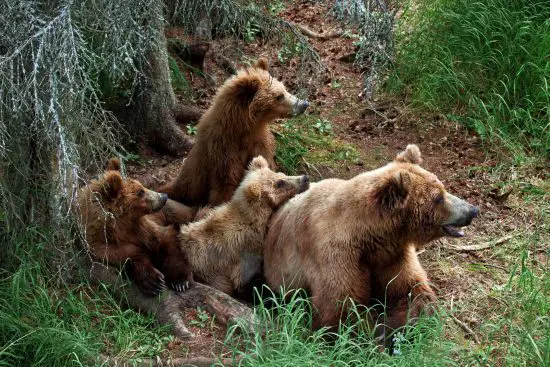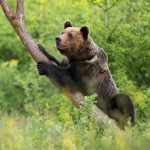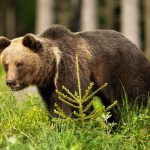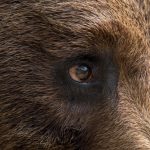Grizzly bears, a subspecies of brown bears, have faced significant challenges over the years, resulting in a decline in their population. In the lower 48 states, grizzly bears were placed on the endangered species list back in 1975 after their numbers had almost been entirely wiped out.
Today, the grizzly bear can only be found in about 6% of their historic range due to habitat loss and human-related activities.

There are several factors contributing to the rarity of grizzly bears, including habitat destruction, climate change, and conflicts with humans. The encroachment of human developments into the bears’ territory has led to the fragmentation of their habitat, making it more difficult for them to find food and breed successfully.
Additionally, climate change has had a direct impact on their food sources, with shifting ecosystems affecting the availability of their primary prey. Conflicts with humans also pose a significant threat, as bears that venture too close to human-populated areas often end up being killed to protect life and property.
Although grizzly bears are still considered threatened in the contiguous United States, conservation efforts have helped to stabilize and even increase their populations in some areas.
Ongoing measures have been implemented to protect their habitats, minimize human-bear conflicts, and maintain viable population sizes. It is crucial to continue these efforts to ensure the long-term survival of these magnificent animals in their natural habitats.
Grizzly Bear Classification and Characteristics
The grizzly bear (Ursus arctos horribilis) is a subspecies of the brown bear, native to North America. Grizzly bears are characterized by their distinctive hump on their shoulders and long, curved claws. These bears have a varied diet, consuming both vegetation and small mammals, such as elk and deer.
Grizzlies are currently classified as a threatened species in the 48 contiguous United States. This means that these bears are protected under the Endangered Species Act, making it illegal to harm, harass, or kill them.
The rarity of grizzly bears is due to various factors such as habitat loss, human encroachment, and climate change. These factors have significantly impacted their population size, especially in areas where they were once abundant. In some regions, the grizzly bear population has become extinct or is struggling to survive.
Threats to the grizzly bear population include:
- Habitat loss due to human development and agriculture reduces the availability of food and shelter for these bears.
- Human-wildlife conflicts such as encounters between grizzlies and humans, often lead to the bears being killed for safety reasons.
- Climate change contributes to a decline in their natural food sources, such as berries and fish.
- Poaching and illegal killing, despite the protections under the law.
Grizzly Bear Population and Distribution
Grizzly bears (Ursus arctos horribilis) were once widespread across North America, but their populations have significantly decreased due to habitat loss and human activities. In the 48 contiguous United States, grizzly bears are currently protected as a threatened species, making it illegal to harm, harass, or kill them.
Today, the distribution of grizzly bears is much smaller than their historic range, with their habitat dwindling to about 2% of historic habitat in the Lower 48 states. The largest population of grizzlies in the United States can be found in the Greater Yellowstone Ecosystem and the Northern Continental Divide Ecosystem. Grizzly bears are also found in parts of Montana, Idaho, Wyoming, and Washington.
In Canada, grizzly bear populations are generally stable, with an estimated 15,000 individuals. Their distribution in Canada spans from the Yukon Territory and northern British Columbia to the western part of Alberta.
Grizzly bears face numerous threats that have contributed to their rarity. Major threats include:
- Habitat loss and fragmentation caused by human development and resource extraction
- Poaching and illegal killing of bears
- Human-bear conflicts due to food sources and encroachment on bear habitat
- Climate change impacting their food supply and habitat
Conservation efforts focusing on population recovery, habitat preservation, and reducing human-bear conflicts are crucial to helping maintain and potentially increase grizzly bear populations.
Endangered Status and Legal Protection
Grizzly bears have faced various threats, leading to their status as a rare and endangered species in certain areas. In this section, we will explore their classification on the IUCN Red List and their protection under the United States Endangered Species Act.
IUCN Red List
The International Union for Conservation of Nature (IUCN) classifies grizzly bears (Ursus arctos horribilis) as a subspecies of the brown bear (Ursus arctos). Brown bears are currently listed as “Least Concern” on the IUCN Red List due to their wide distribution and global population numbers. However, this status does not necessarily reflect the situation of grizzly bears in specific regions, especially those within the United States, where populations may face higher threats and be more vulnerable.
United States Endangered Species Act
Under the United States Endangered Species Act, grizzly bears in the 48 contiguous states have been classified as a threatened species, which means they require special protection due to their declining population numbers and the various threats they face. These threats include habitat loss, human encroachment, climate change, and fragmentation of populations.
Several efforts have been made to help conserve and recover grizzly bear populations in the United States. For example, in the Yellowstone region, the grizzly bear population has shown signs of improvement, but their Endangered Species Act protections were briefly removed in 2017 before being reinstated in 2018.
In conclusion, while the overall status of grizzly bears on the IUCN Red List may not seem alarming, the situation in specific regions, like the United States, requires ongoing efforts to ensure their survival and protection from the various threats they face.
Section 5: Threats to Grizzly Bear Populations
Grizzly bears face numerous threats that contribute to their rarity and endangered status. Understanding these challenges is crucial for conservation efforts aimed at protecting and preserving these majestic animals.
Habitat Loss
One of the primary threats to grizzly bears is habitat loss. As human populations continue to grow, there is increased pressure to develop land for housing, agriculture, and other purposes. This development leads to the fragmentation of the bears’ natural habitats and restricts their access to essential resources such as food and shelter. Consequently, the bears are forced into smaller and more isolated areas, putting their populations at increased risk of inbreeding and eventual extinction.
Human Conflicts
Grizzly bears may come into contact with humans in their search for resources, which can lead to dangerous encounters. These conflicts may result in human injuries or fatalities, as well as bears being killed in self-defense or as a preventive measure. In some cases, bears may associate human activities with food, increasing the likelihood of future conflicts. Grizzly bears are currently protected by law in the 48 contiguous United States as a threatened species, and it is illegal to harm, harass or kill them. However, conflict with humans still poses a significant threat to their survival.
Climate Change
Climate change is another factor that can adversely impact grizzly bear populations. Altered temperature and precipitation patterns have the potential to significantly change the ecosystems in which these bears live, affecting the availability and distribution of their food sources. For instance, an earlier spring or a warmer winter could disrupt the natural cycle of plant growth and berry production, which are critical for the bears’ diet. The effects of climate change on grizzly bear habitats are not yet fully understood, but there is concern that these changes may compound the challenges already faced by these animals due to habitat loss and human conflicts.
Section 6: Conservation Efforts
Grizzly bear conservation efforts focus on several key aspects, including habitat restoration, reducing human-bear conflicts, and implementing reintroduction programs.
Habitat Restoration
Habitat restoration is crucial to ensuring the survival of grizzly bears. This involves preserving and expanding the available habitat by protecting vital ecosystems and corridors that allow grizzly bears to roam freely and connect with other populations. The goal is to minimize fragmentation and create sustainable environments.
Reduce Human-Bear Conflicts
Human-bear conflicts are a major threat to grizzly bear populations. Consequently, it is important to reduce these encounters through education and the implementation of improved waste management practices. This includes using bear-resistant garbage containers, educating people on bear awareness, and establishing guidelines for campers and hikers to avoid accidentally attracting bears. These measures can help prevent unnecessary deaths of both bears and humans.
Reintroduction Programs
Reintroduction programs are another way to help recover grizzly bear populations. This approach involves releasing grizzly bears back into their historical range to establish new populations, or to supplement existing populations which may be struggling due to inbreeding or low numbers. By doing so, the genetic diversity is increased, offering the bears a better chance of long-term survival.
How aggressive are grizzly bears?
Grizzly bears have a reputation for being aggressive, mainly due to their size and strength. While they generally avoid confrontation with humans, grizzlies can be assertive when provoked, particularly when defending their cubs or food sources. This assertiveness is usually a method of self-preservation and protection, rather than an intent to harm.
Compared to black bears, grizzly bears are usually more aggressive and rely on their size and aggressiveness to fend off potential threats. However, each bear’s temperament is unique and can be influenced by various factors such as hunger, stress, or even health.
Can I outrun a grizzly bear?
Attempting to outrun a grizzly bear can be a risky decision as they are much faster than humans. Grizzly bears can reach speeds of up to 30 miles per hour (48 kilometers per hour), making it impossible for even the fastest human to outrun them.
Experts recommend other approaches, such as speaking calmly, avoiding direct eye contact, and slowly backing away without turning your back to the bear. If the bear approaches, you should stand your ground and try to make yourself appear larger by raising your arms and standing on your tiptoes. In the rare event that the bear initiates an attack, using bear spray or playing dead are potential strategies to survive the encounter.
While grizzly bears can be aggressive, it is essential to remember that they prefer to avoid confrontations with humans when possible. Understanding their behavior and taking necessary precautions can reduce the risk of injury and promote coexistence with these magnificent creatures.
Are Bobcats Considered a Threat to Cats and Dogs?
Bobcat attacks on pets have become a concern for pet owners in certain regions. While bobcats generally avoid human interaction, they may perceive smaller animals like cats and small dogs as prey. Pet owners should be vigilant, especially in areas where bobcat populations are prevalent, and take measures to protect their pets, such as keeping them indoors or supervising them closely when outside.
Conclusion
Grizzly bears are currently classified as threatened under the Endangered Species Act (ESA), primarily due to habitat loss, human-wildlife conflict, and fragmentation of their populations. Their rarity can be attributed to historical overhunting and the ongoing challenges they face in terms of conservation and protection.
One of the primary threats to grizzly bears is habitat fragmentation. Loss of connectivity between ecosystems poses a risk to their genetic health since isolated populations are vulnerable to inbreeding and eventual extinction. Human encroachment into bear habitats further exacerbates this issue, as it can lead to more human-bear conflicts, resulting in the removal or death of bears.
Efforts to conserve grizzly bears must focus on habitat protection, reduction of human-wildlife conflicts, and the promotion of connectivity between ecosystems to ensure their long-term survival. By addressing these challenges, it is possible to provide a stable and secure environment for these iconic creatures and avoid their extinction.









